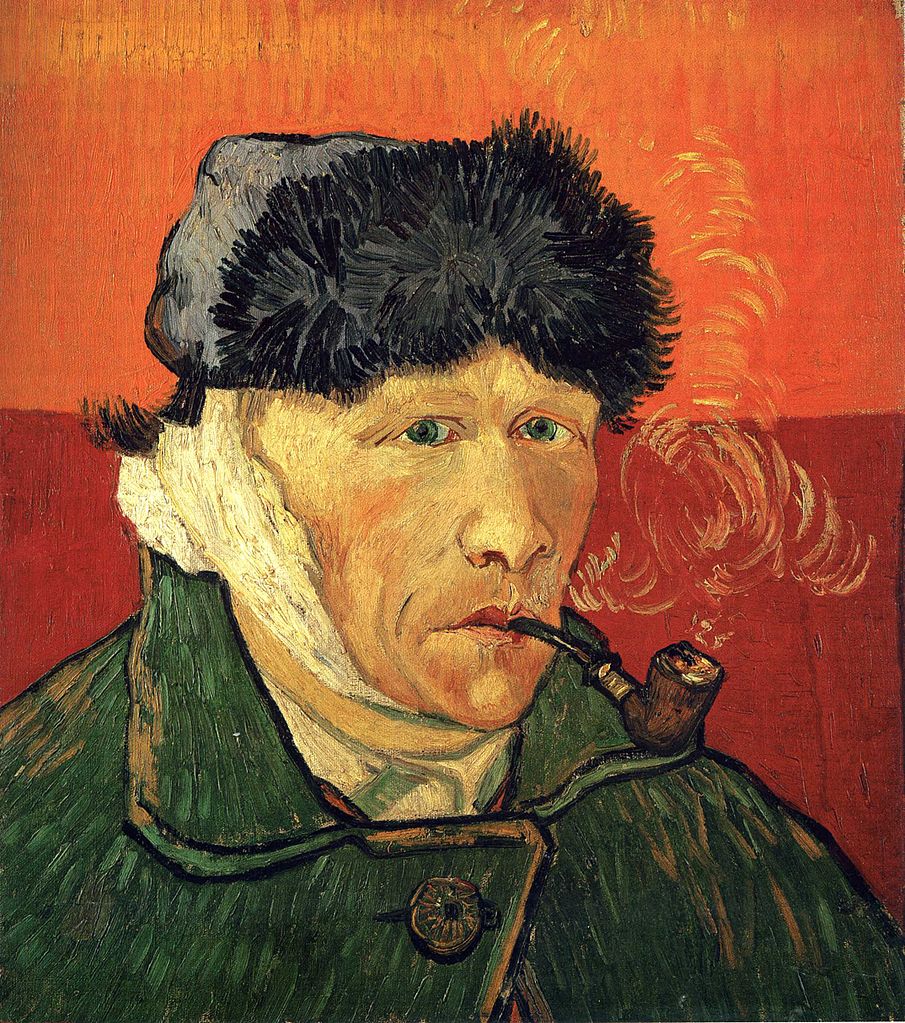Vincent Van Gogh was an admired artist, who was also a troubled and “tortured genius.” His artwork, Starry Night, Bedroom in Arles, and many others have earned him fame and recognition as one of the greatest artists of his time. But what many remember most about this artist is the story of his severed ear. Although his art is exemplary, his struggle with mental health and self-harm is admirable. His struggle was overlooked due to his incredible talent. He was successful as an art dealer, but as an artist, he had to prove himself with the headquarters of international art dealers, Gopil & Cie. During his lifetime, Van Gogh was the poster boy for the image of starving artist. His artwork was not recognized until much later in his career, which could have been a leading cause of his major depression and anxiety.1
Van Gogh, born in the Netherlands, decided to start his career in Paris in the 1880s, where many of the age’s great artists also resided. He believed he could get recognition for his pieces through his younger brother, Theo, who made his living as an art dealer. His brother introduced him to many artists, including Georges Seaurat, Camille Pisatto, and Paul Gauguin. Upon meeting these successful artists, Van Gogh was greatly inspired by their work and began creating his own artistic style, beginning in 1883. Later the same year, Van Gogh rented a small house in Arles, in the south of France. Paul Gauguin and Van Gogh became close friends and later roommates. They consistently bounced ideas off of each other and created a strong friendship.2

Like many friendships, theirs was rocky, and they found themselves drifting apart. Gauguin had moved on to a different artistic style and was exploring other ideas. Van Gogh at the time, had been reciprocating signs of depression and mental health issues, but at the time, these symptoms were considered normal. When Gauguin decided to explore other art spectrums, it involved moving out of the house he and Van Gogh shared. He broke the news to his roommate about his intentions, and this evidently this made Van Gogh go over the edge. He did not take the news lightly and both men began verbally arguing. Van Gogh had disappeared for a few hours and when he returned to confront Gauguin, he had a razor blade in hand threatening to hurt Gauguin.3
During the confrontation, however, Van Gogh was hesitant to hurt his friend and decided to turn the blade on himself and completely cut off his ear. Gauguin left him bleeding and alone. Van Gogh bandaged his head and began drowning himself in alcohol. During this episode, he walked out of his home and into the streets where he found a prostitute. The ear that he had severed off of himself had been neatly wrapped in a cloth; since Van Gogh was still heavily intoxicated, he decided to present this token to the prostitute. Patiently, she ran off and alerted the police about her encounter and they immediately rushed to his home.4
Shortly before Christmas Eve, Van Gogh was found by police in his bed, partially conscious and with major blood loss. Authorities rushed him to the hospital where he surprisingly recovered. Meanwhile, Gauguin was brought into questioning, but gave no testimony on the incident. It was believed that Van Gogh had suffered a severe mental breakdown long before he had severed his ear, but that this created a ripple effect that led to lunacy. The real reason behind the infamous Van Gogh ear-cutting may never be known; Gauguin had promised Van Gogh a pact of silence on the situation in letters that they supposedly exchanged. 5

After the incident, Van Gogh was admitted into a psychiatric facility in hopes of recovering mentally and physically. The dramatic change was not helpful for such a troubled artist, and in July of 1890, Vincent Van Gogh ended his life with a revolver. Before his suicide, however, he created a very iconic painting, Self Portrait with Bandaged Ear 1889. Van Gogh intended to persuade his doctors that he was perfectly able to continue working and creating art by creating this self portrait. He presented his piece, leaving a trail of wonder for his supporters as to why he included certain details in this particular piece, mainly because he continued to paint himself in the same yellow house he and Gauguin shared. Doctors overlooked these details and allowed Van Gogh to leave the facility.6
The epidemy of many artists like Van Gogh is often associated with mental instability, drug use, and alcohol abuse. Van Gogh had an array of medical issues that were tied back to his coping mechanisms (alcohol abuse), and as a result, many did not understand the struggles he faced and degraded him as a person while idolizing his artistic talent. As said before, the real reason behind his mutilated ear will be unclear, but his work and talent will continue to inspire and educate.
- Adam Gopnik, “Van Gogh’s Ear,” The New Yorker, Literature Resource Center (January 4, 2010): 48. ↵
- “Who Really Cut Off Van Gogh’s Ear?” Weekend All Things Considered, Literature Resource Center, (May 2010). ↵
- “Who Really Cut Off Van Gogh’s Ear?” Weekend All Things Considered, Literature Resource Center, (May 2010). ↵
- Belinda Thomson, “Comparing lives: issues of balance in biographical writing,” Literature Resource Center, French Politics, Culture and Society 24, no. 2 (2006): 60. ↵
- Tim Suermondt, “All the Answers.” Literature Resource Ceter, Prairie Schooner 85, no.3 (2011): 47. ↵
- Tim Suermondt, “All the Answers,” Literature Resource Center, Prairie Schooner 85, no. 3 (2011): 47. ↵



170 comments
Thomas Fraire
I learned about Van Gogh in my SMC Fine Arts class and was fascinated at how bizarre his life was. I didn’t realize the reason or part of the reason he was the way he was is because of mental health. This is not something that is acknowledged a whole lot in society today. So back then it must have been even worse. It is really tragic at how much he struggled and it’s even more tragic how he lost his life alone bleeding out. This article was written very well and I enjoyed it a lot.
Katherine Wolf
Van Gogh’s life story always makes me sad because someone who had so much sorrow but so much talent, did not see the impact they had on the world. His story also worries me because many people idolize him and seem to add to the dangerous narrative that great artists must suffer for their work, and that can lead to glorifying mental illness.
Ava Rodriguez
I always heard about Van Gogh doing really crazy things for art like when he was depressed he ate paint that resembled happy colors because he thought it would make him happy. It is really hard to read how his mental illness was ignored and led to his ear being cut off. It is so sad that his friend left him to bleed out and he was alone.
Engelbert Madrid
Before reading this article, I only knew Van Gogh by his famous paintings “The Starry Night” and his self-portrait that are now two of the most important pieces of art in art history. However, I didn’t know that he struggled depression, anxiety, and suicidal thoughts, which led him to his death. It is quite saddening to know that this talented painter ended his life in a horrible way, but now his works are remembered and taught in the history of art and paint.
Averie Mendez
It’s so sad that this man created so many beautiful pieces of artwork but failed to see the beauty/impact he had in the world. I hate to see that so many people romanticize his sadness, specifically, the yellow paint incident. He was severely mentally ill in an era that overlooked that too often. It’s also so sad that his friend abandoned him in his time of need.
Andres Cano
I think it is amazing that through all of his mental health issues, his artistic passion always came to be his priority despite the degradation he undeniably received from others. However it is sad that during his lifetime he was such a sick man and confusing since I never associated his artwork with any of the negative emotions he faced during his lifetime. When I think of Van Gogh, I always think of a man with a dream, willing to face all adversity to present his creativity. Sad that he had to go as he did.
Mia Morales
This article just goes to show that no matter the type of fame and influence someone may have on others, it is always important to still be mindful of what they might be going through. Even people who are openly expressive, whether it be through art or vocally, have to deal with mental health. It is always sad that people only seem to care after it is too late.
Maya Mani
It’s devastating that an individual with so much talent, was also degraded. People idolized his skills and yet overlooked his mental health. He expressed himself and did everything he needed to do, telling other people how he felt, or expressing his emotions in his art. To no avail, people simply thought it was “normal”. Well written article, but it’s such a sad story.
Diego Terrazas
I wonder if Van Gogh would be the same artist if he were healthy mentally. I have read that some artists cannot make art if they are not under a type of influence such as alcohol and drugs. However, the fact that Gauguin left him, I cannot imagine the sadness he felt and the isolation he resided in. I wonder if he portrayed his sadness in his paintings.
Makenzie Santana
Van Gogh is legend, it hurts to know how he became one tho. Quite talented but so troubled, if only his mental instability hadn’t been overlooked. I also find it heartbreaking to know that a dear friend of his left him to bleed out by himself. I really feel for this artist and his struggling inner pain. Such a sad thing to know about Van Gogh and that there may have been something done to prevent the horrible ending of his life.